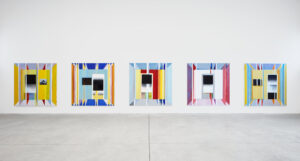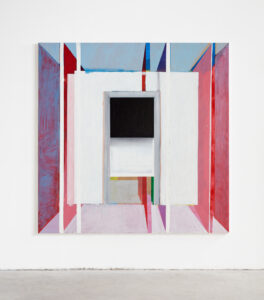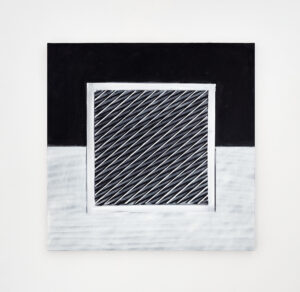If one thinks of geometric abstractionism in painting, one is instinctively tempted to associate it with compositions of pure and two-dimensional shapes, more or less intensely enlivened by the unpredictability of color according to the orientation of the researches of the various authors who, when they explicitly refer to this context, generally refuse any figurative suggestions to which their compositions may accidentally give rise. This language, developed at the beginning of the 20th century and rapidly spread in different national variations, such as Suprematism, Neoplasticism, Constructivism or Cercle et Carré, was based on the abolition of the third dimension and on the detachment from emotional values, with the aim of promoting a rational approach that was able to restore order and harmony to the chaos of reality. These principles, variously reinterpreted and even “betrayed” in their ideological rigor over the years, are still the founding elements of the most recent research, which confirm the timeless vitality of a branch of painting in investigating the relationships between shapes and colors in a rhythmic and numerical sense.

Farid Rahimi. Screen Rooms, 2023, installation view at KAPPA-NÖUN, San Lazzaro di Savena (BO), courtesy the artist and KAPPA-NÖUN
Compared to these premises, obviously generic and not exhaustive, Farid Rahimi’s painting (1974, Lausanne, Switzerland. Lives and works in Milan) is placed in an interesting position of dialectical confrontation, even if on first examination it seems to embrace with conviction all their stylistic and expressive consequences. An opportunity to delve into his eccentric poetics is the Screen Rooms show, recently inaugurated at KAPPA-NöUN (exhibition space founded in San Lazzaro di Savena, near Bologna, by the collector Marco Ghigi), where the artist presents the latest of his experimentation in the homonymous cycle of new works, which are proposed as a natural evolution of the Empty walls series, on which he had concentrated in previous years. If in the latter the recurring motif was a corner formed by two walls where other openings, similar to doors or windows, complicated the perspective construction by preventing an all-encompassing vision of the pictorial space, here the viewer’s gaze, instead of remaining on the threshold of the image, is perceptually “sucked” into it until he finds himself trapped in a labyrinth of intersecting and overlapping mental planes where it is even more difficult to decide whether what one finds from time to time is an opening or a backdrop.

Farid Rahimi, Screen Room 4, 2022, oil on canvas, 180 x 180 cm, courtesy the artist and KAPPA-NÖUN
Also in Screen Rooms the artist, whose primary interest (according with the rigorous canons of analytical painting) is the definition of the fictitious space of the image through abstract elements and color fields, seems to use the architectural reference evoked by the title as alarm signal to warn us against the ambiguous and conventional nature of any rigid categorization. While on the one hand his compositions are the result of long evaluations on the balance of the chromatic and formal relationships put into play, on the other hand the choice of the final arrangement of the painting (that is the decision to interrupt the sequence of stratifications and glazes through which it takes shape) ultimately responds to an instinctive and emotional impulse. For Farid Rahimi, in fact, what at first sight might appear as a structural grid that spatially scans the vision is the result of an intuitive superimposition of brushstrokes never subordinated to a predetermined project design, but freely guided by provisional masking that delimit the painting areas during construction. This irrational component, which is paradoxically amplified and not contained by the grid as the eye pursues the multiplication of its enigmatic lags, emerges almost treacherously just when the application of logic would seem maximum.

Farid Rahimi, Screen Room 2, 2022, oil on canvas, 180 x 180 cm, courtesy the artist and KAPPA-NÖUN
The large color fields that define the different parts of the painting are therefore created in a partially random way as a development of the idea that behind the pictorial planes that they identify there may be infinite other potential images. What we manage to glimpse are then only some possible manifestations of the innumerable parallel universes that the spatio-temporal co-presence evoked by painting are capable of activating. In confirmation of this, we note how each painting can be fragmented into an ideally unlimited number of visual portions, each of which can be considered as an autonomous work that does not need the rest to have coherence and meaning. If instead we focus on the overall vision, the impression is that at the origin of the mysterious cohesion that it manages to maintain, despite the proliferation of its internal contradictions, there is precisely the artist’s intention to “put into perspective” his abstract imagery, originally made up of rhythmic successions of chromatic entities that are not in themselves alluding to depth. The unorthodox vanishing point of this multicentric perspective is the black panel which appears in different positions and dimensions in each painting and which we could consider the keystone of Farid Rahimi’s visual constructions, both in its function of rhythmic punctuation and as embodiment of the equivocal coincidence between the illusion of depth and the perceptive barrier.

Farid Rahimi, Trappola 2, 2023, mixed media and oil on canvas, 70 x 70 cm, courtesy the artist and KAPPA-NÖUN
The importance of this element is reaffirmed by Trappola 2 (2023), a work which by itself, in its radical extraneousness to the other paintings on display, assumes in their regard the double value of visual counterpoint and conceptual clue that reaches straight to the heart of the artist’s poetics. While the paintings in the Screen Rooms series solicit perception with a virtuosic proliferation of chromatic preciousness and hints of latent figuration in which the unexpected and irreducible subjectivity of geometric abstraction seems to triumph, the radical bichromatism played on black and white we find in Trappola 2 appears as a peremptory programmatic statement. The perfectly complementary relationship between these two colours, also considered in their reciprocal intersections when they overlap to become a network, imprisons the gaze in an unsolvable impasse between vision and its negation, in which the artist’s commitment to explore from a conceptual point of view the constitutive indeterminacy of the status of the image in painting. And it is precisely by reasoning in these terms that in my opinion it emerges more clearly what the evolution of Farid Rahimi’s research consists of in the transition from the Empty walls series to Screen Rooms: no more the emphasis on the abstract deconstruction of the deceptive perception of an environment, but the analysis of the variations of a room-screen conceived as a laboratory and archive of images in which every appearance implies a concealment and a subtraction.
Info:
Farid Rahimi. Screen Rooms
06/04/2023 – 14/05/2023
KAPPA-NÖUN
Via Imelde Lambertini 5 – San Lazzaro di Savena (BO)
Graduated in art history at DAMS in Bologna, city where she continued to live and work, she specialized in Siena with Enrico Crispolti. Curious and attentive to the becoming of the contemporary, she believes in the power of art to make life more interesting and she loves to explore its latest trends through dialogue with artists, curators and gallery owners. She considers writing a form of reasoning and analysis that reconstructs the connection between the artist’s creative path and the surrounding context.






NO COMMENT